Private issues (other shops etc)
Barbers
Peluquería de Los Baños de San Agustín

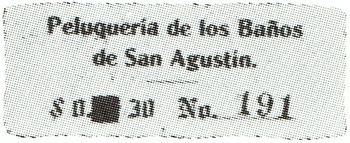 M1419 30c Baños de San Agustín
M1419 30c Baños de San Agustín
A 30c note from a barber's shop. The Baños de San Agustín, below Hotel San Agustín, situated at Bajos de San Agustín, núm. 1, were the best in Mexico City (of course they were).
Peluquería Imperio
![]()
A 10c note[image needed] from another barber's shop, at Gante 1, run by Fructuoso Vallecillo.
Bath-houses
Baños de los Arquitos
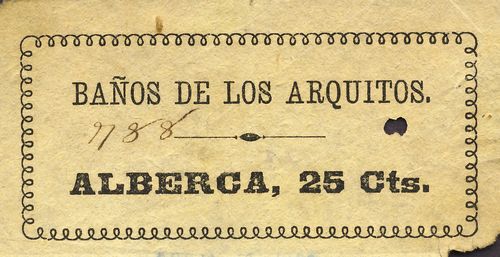 M1283 25c Baños de los Arquitos
M1283 25c Baños de los Arquitos
| from | to | total number |
total value |
||
| 25c | includes number 1188 |
Presumably named after the famous Baños de los Arquitos in Aguascalientes, constructed in 1821. 'Alberca' is the swimming pool.
Baños del Factor
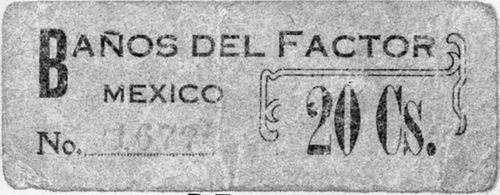 M1286 20c Baños del Factor
M1286 20c Baños del Factor
| from | to | total number |
total value |
||
| 5c | |||||
| 20c | includes number 1677 |
This bathouse with all the latest luxuries and conveniences was opened in February 1885Le Trait d'Union, 31 January 1885 at 2a calle del Factor 6. A 5c vale from this bathhouse was included in Casasola's expositionhttps://mediateca.inah.gob.mx/repositorio/islandora/object/fotografia%3A191511.
Baños del Harem

These baths, at calle 3a. Bolivar 26, were run by J. Fernández y Cía.
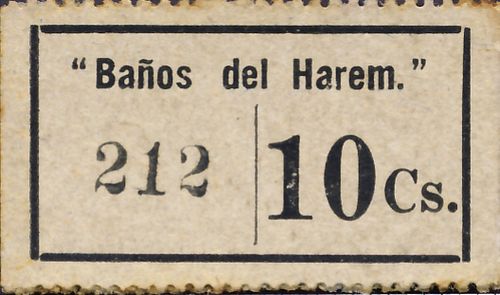
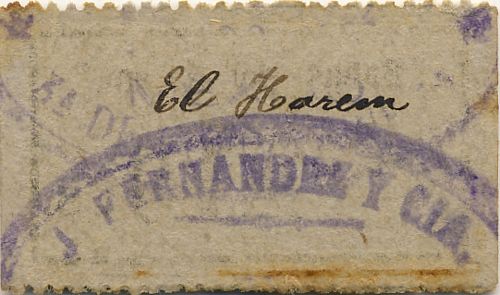 M1288 10c Baños del Harem
M1288 10c Baños del Harem
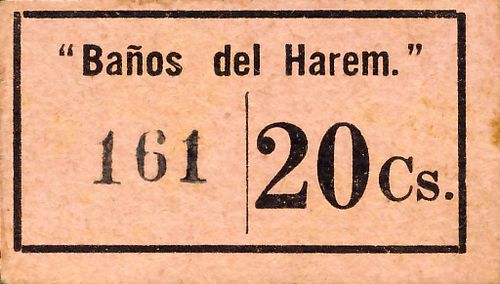
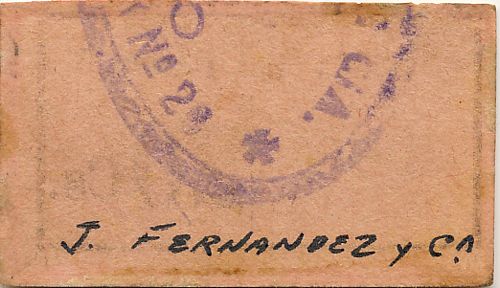 M1289 20c Baños del Harem
M1289 20c Baños del Harem
| from | to | total number |
total value |
||
| 10c | includes number 212 | ||||
| 20c | includes numbers 121CNBanxico #10796 to 161 |
Gran Baño de San Felipe de Jesús

 M1378 10c Gran Baño de San Felipe de Jesús
M1378 10c Gran Baño de San Felipe de Jesús
This bathhouse was situated at calle de Venero 538 and San Felipe 17 and 18. In August 1888 it had been acquired and renovated by Amado García, the founder of the Baños de la CoronaEl Monitor Republicano, 13 October 1888.
This boleto states that it is accepted in the baths' barbershop.
Hotels
Billares Gillow
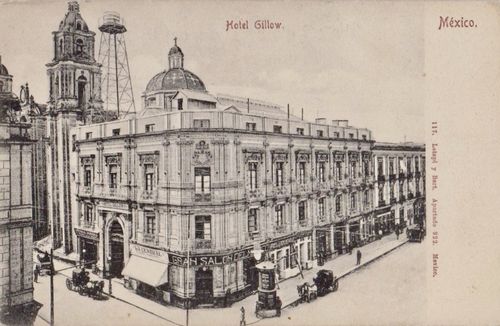

This pool hall was set up in early 1911 in the basement of the hotel of the same name, with entrances on Avenida Isabel la Católica and Avenida 5 de MayoEl Imparcial, 7 March 1911. It was run by Santoyo Picazo y Cía.
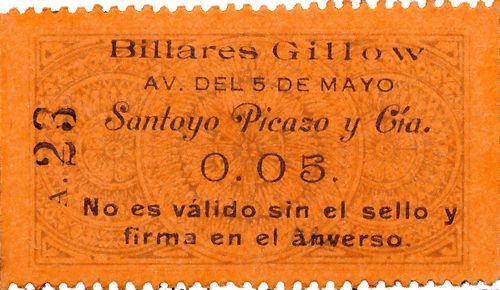
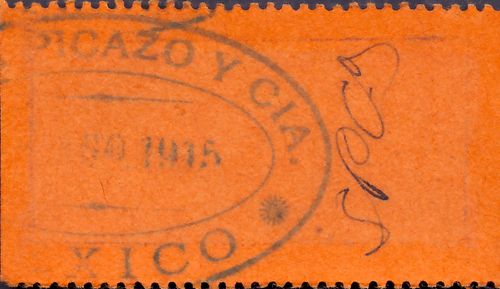 M1291 5c Billares Gillow
M1291 5c Billares Gillow
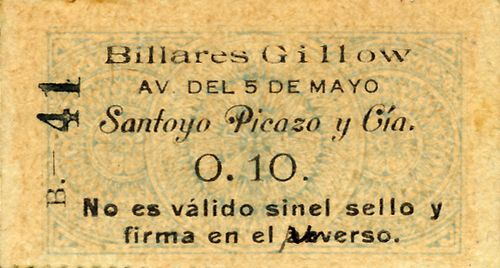
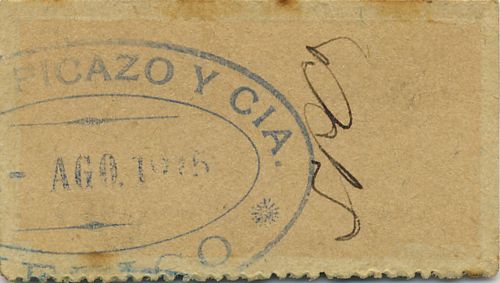 M1292 10c Billares Gillow
M1292 10c Billares Gillow
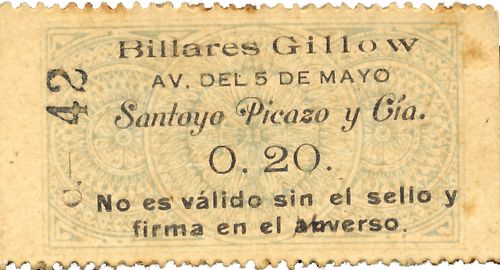
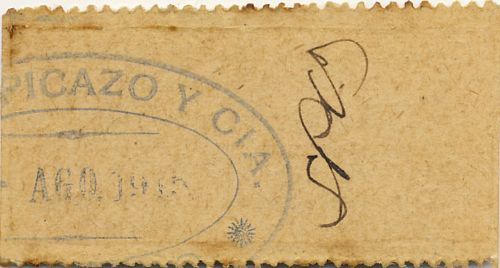 M1293 20c Billares Gillow
M1293 20c Billares Gillow
| series | from | to | total number |
total value |
||
| 5c | A | includes number 23 | ||||
| 10c | B | includes number 41 | ||||
| 20c | C | includes number 42 |
A 5c note was included in Casasola's expositionhttps://mediateca.inah.gob.mx/repositorio/islandora/object/fotografia%3A191511.
Hotel Palacio
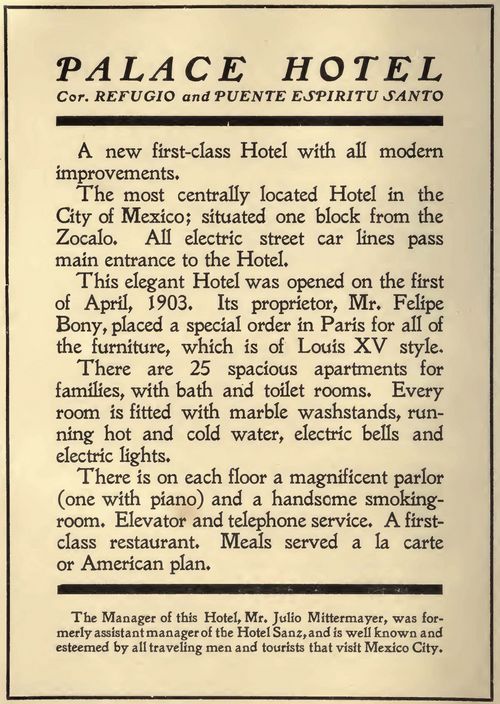
The elegant Hotel Palacio, situated one block from the Zócalo, opened in April 1903. It had a first class restaurant, with meals served a la carte or American Plan (three meals a day included in the hotel rate). These notes will have been used in the restaurant or bars (the Moctezuma Orizaba, that has no rivals, is a beer).
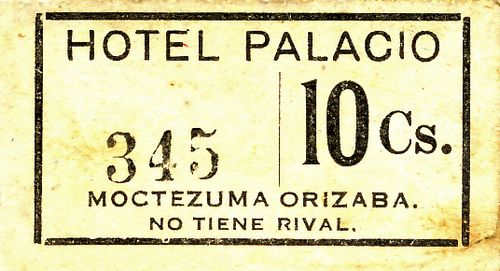 M1380 10c Hotel Palacio
M1380 10c Hotel Palacio
| from | to | total number |
total value |
||
| 5c | |||||
| 10c | includes number 329CNBanxico #12316 to 345 |
Shops
“La Abeja”
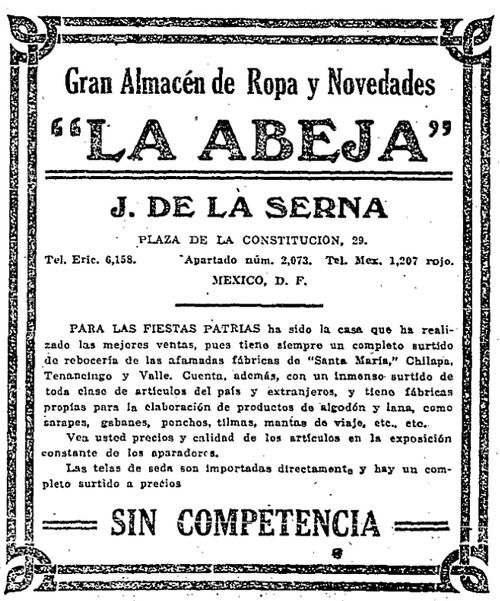
La Abeja”, a department store at Plaza de la Constitución (the Zócalo), 29, owned by J. de la Serna, offered a complete range of oak furnishings and an immense assortment of Mexican and imported goods, and had its own factories producing cotton and wool articles.
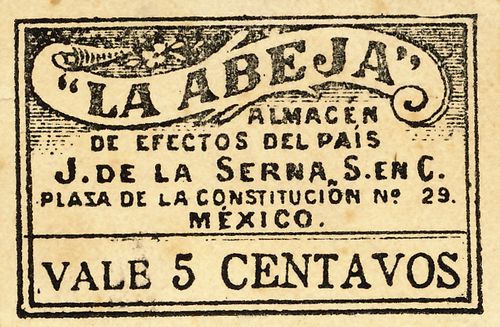 M1382 5c La Abeja
M1382 5c La Abeja
Farmacía y Droguería “Colon”
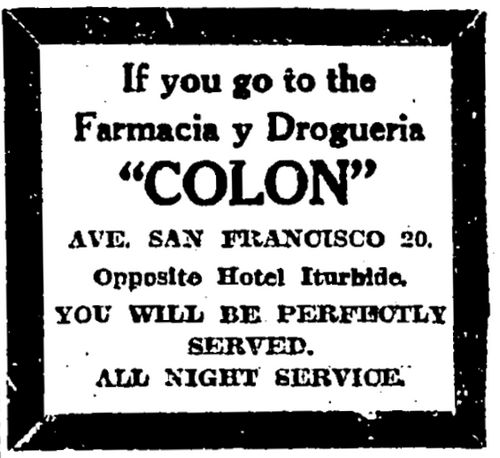 The new Colon drugstore, situated at Avenida de San Francisco núm. 20 and owned by the firm of Parra y Cía., “fitted with every luxury and to the most demanding needs of modern pharmacopoeia”, was opened on 1 November 1913El Correo Español, 30 October 1913.
The new Colon drugstore, situated at Avenida de San Francisco núm. 20 and owned by the firm of Parra y Cía., “fitted with every luxury and to the most demanding needs of modern pharmacopoeia”, was opened on 1 November 1913El Correo Español, 30 October 1913.
A 50c note dated 31 June 1915[image needed].
La Popular
A 10c note[image needed] from a store located at Palma and 5 de Mayo.
"La Providencia"
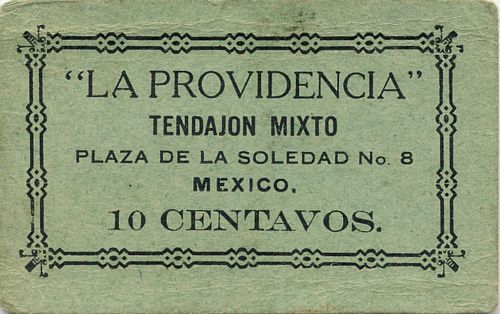 M1409 10c La Providencia
M1409 10c La Providencia
Lázaro Petrides Tabaquería
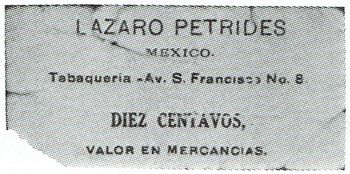 M1412 10c Lazaro Petrides
M1412 10c Lazaro Petrides
A 10c note from a tobacconist, situated at Avenida San Francisco 8. The Avenida San Francisco was renamed Avenida Francisco I. Madero by Pancho Villa on 8 December 1914, but still has its former name in adverts of 1915.
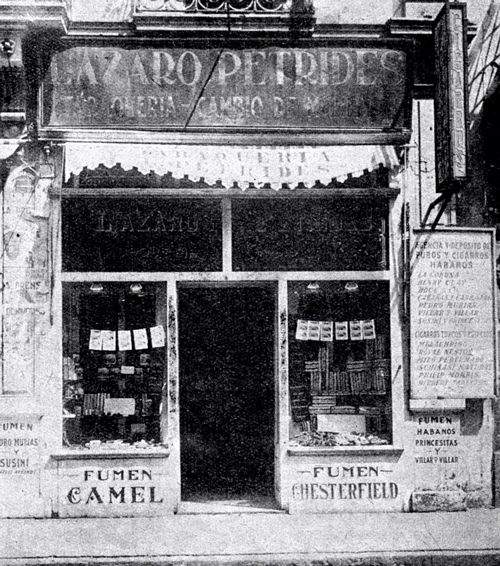
In 1875 Lázaro Petrides, a Cypriot immigrant, opened the first cigar and cigarette shop in Mexico. It soon became a must-see stopover for connoisseurs, and even Pancho Villa himself, they say, ordered his cigars here. Petrides had also moved into money changing by May 1915The Mexican Herald, Año XX, No. 7,178, 3 May 1915 and received a licence as a casa de cambio.
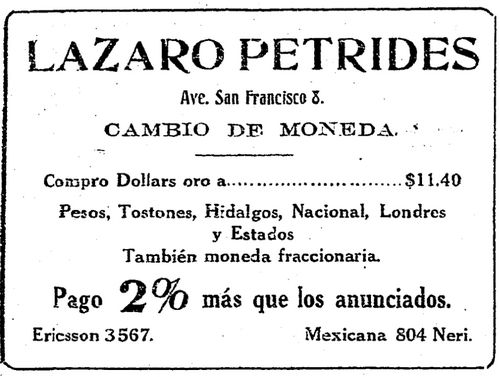
advertisement from May 1915
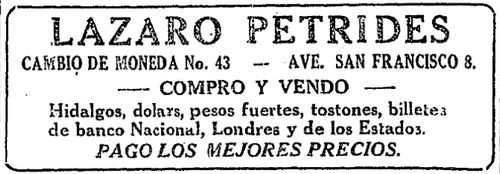
advertisement from October 1915

advertisement from April 1919
On 22 January 1916 he was also appointed managing director and treasurer of the newly-founded Compañía Petrolifera “El Verjel”, S. A. which had a capital of $1,500,000El Pueblo, Año III, Tomo I, Núm. 474, 13 February 1916.
Petrides’ business closed and his descendants emigrated to the United States, but his brothers and nephews, who arrived in Mexico fleeing the war in Europe in 1939, also opened a shop, Hermanos Petrides, in calle de Uruguay, which continues the tradition and is still an essential stop for heavy cigar smokers.
Theatres and cinemas
Parisiana
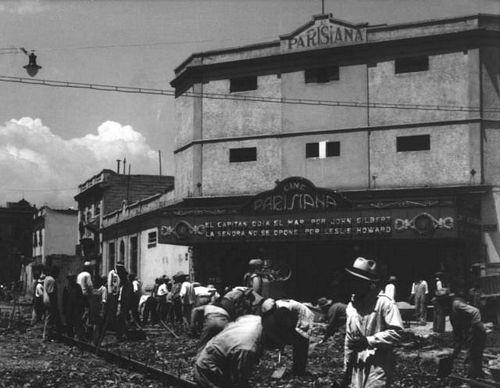
A cinema located at 5a Limantour (later calle Abraham González) and 2a Barcelona. It was remodelled in 1941 and was still open in 1955 but had closed by 1971. The building was later demolished and replaced with an apartment building that was destroyed in the 1985 earthquake.
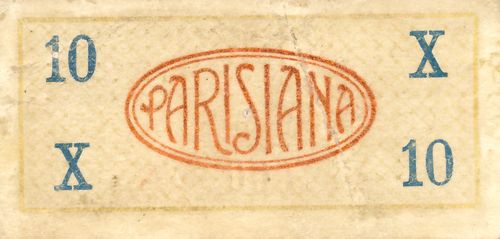
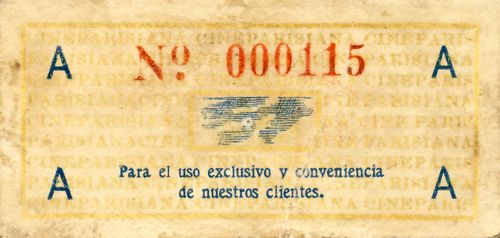 M1416 10c Parisiana
M1416 10c Parisiana
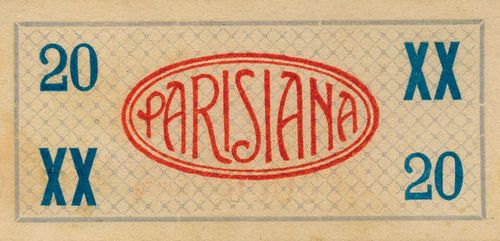 M1417 20c Parisiana
M1417 20c Parisiana
| series | from | to | total number |
total value |
||
| 10c | A | 000001 | includes numbers 000115 to 001371CNBanxico #10812 | |||
| 20c | B | 000001 | includes number 000209CNBanxico #10813 |
Again, these seem unlikely, but confirmation comes from the fact that they were included in a display of vales photographed by Casasola in c. 1914https://mediateca.inah.gob.mx/repositorio/islandora/object/fotografia%3A191511.
Salón Rojo
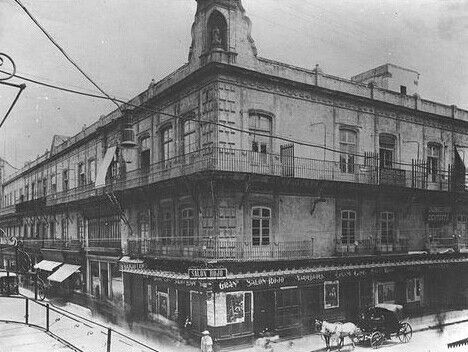
Jacob(o) Granat was born in 1871 in Lemberg (today Lviv), a city in Ukraine, at the time part of the Austrian empire. In 1900, at the invitation of his uncle Jacob Kalt, he moved to Veracruz, and a year later to Mexico City. Granat quickly became the “curio king” of the capital, selling luggages, post cards and other souvenirs from his shop in calle San Francisco.
In 1906, Granat sold his shop to purchase the old Borda palace, on the corner of Madero and Bolivar, where he opened the first movie theatre of the city, the famous Salón Rojo. Salón Rojo rapidly became the most luxurious and successful theatre in the city, and a centre of night life for Mexico’s rich and famous. It attracted politicians, notably Francisco Madero, who used to hold political meetings in Salón Rojo, and became a friend for Granat.
in the mid 1920s, Granat sold the Salón Rojo and moved back to Europe, settling in Austria. One of the reasons for his departure was the disappointment and sadness caused by the Madero’s dismissal and assassination. Apparently, he tried to move back to Mexico after the Nazi invasion of Austria, but could not, or was not allowed to, travel, and he and his wife were sent to Auschwitz, where they died in the gas chamber in 1943.
We know of a 20c note from the Salón.
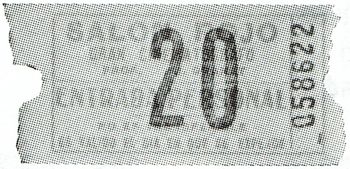 M1432 20c Salón Rojo
M1432 20c Salón Rojo
Teatro "El Alcazar"

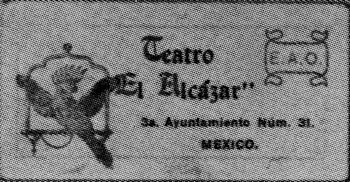 M1438 10c Teatro "El Alcázar"
M1438 10c Teatro "El Alcázar"
The catalogues record a multicoloured 10c note, 70 x 30mm., black, red and sepia on white, though this face, with a cockatoo and the initials 'E.A.O.' does not show a value.
